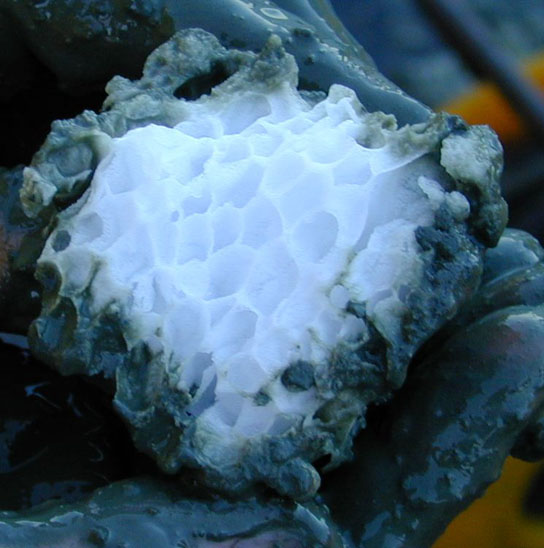
As the demand for oil continues to rise, so does the risk of disasters like the Deepwater Horizon spill that took place in the Gulf of Mexico. A major problem facing deep-sea oil and gas wells is the buildup of methane hydrates, which can sometimes restrict or even block the flow. A new study from researchers at MIT explains how “hydrate-phobic” surfaces may help make deep-sea oil wells safer while improving flow-assurance.
During the massive oil spill from the ruptured Deepwater Horizon well in 2010, it seemed at first like there might be a quick fix: a containment dome lowered onto the broken pipe to capture the flow so it could be pumped to the surface and disposed of properly. But that attempt quickly failed, because the dome almost instantly became clogged with frozen methane hydrate.
Methane hydrates, which can freeze upon contact with cold water in the deep ocean, are a chronic problem for deep-sea oil and gas wells. Sometimes these frozen hydrates form inside the well casing, where they can restrict or even block the flow, at enormous cost to the well operators.
Now researchers at MIT, led by associate professor of mechanical engineering Kripa Varanasi, say they have found a solution, described recently in the journal Physical Chemistry Chemical Physics. The paper’s lead author is J. David Smith, a graduate student in mechanical engineering.
The deep sea is becoming “a key source” of new oil and gas wells, Varanasi says, as the world’s energy demands continue to increase rapidly. But one of the crucial issues in making these deep wells viable is “flow assurance”: finding ways to avoid the buildup of methane hydrates. Presently, this is done primarily through the use of expensive heating systems or chemical additives.
“The oil and gas industries currently spend at least $200 million a year just on chemicals” to prevent such buildups, Varanasi says; industry sources say the total figure for prevention and lost production due to hydrates could be in the billions. His team’s new method would instead use passive coatings on the insides of the pipes that are designed to prevent the hydrates from adhering.
These hydrates form a cage-like crystalline structure, called clathrate, in which molecules of methane are trapped in a lattice of water molecules. Although they look like ordinary ice, methane hydrates form only under very high pressure: in deep waters or beneath the seafloor, Smith says. By some estimates, the total amount of methane (the main ingredient of natural gas) contained in the world’s seafloor clathrates greatly exceeds the total known reserves of all other fossil fuels combined.
Inside the pipes that carry oil or gas from the depths, methane hydrates can attach to the inner walls — much like plaque building up inside the body’s arteries — and, in some cases, eventually block the flow entirely. Blockages can happen without warning, and in severe cases require the blocked section of pipe to be cut out and replaced, resulting in long shutdowns of production. Present prevention efforts include expensive heating or insulation of the pipes or additives such as methanol dumped into the flow of gas or oil. “Methanol is a good inhibitor,” Varanasi says, but is “very environmentally unfriendly” if it escapes.
Varanasi’s research group began looking into the problem before the Deepwater Horizon spill in the Gulf of Mexico. The group has long focused on ways of preventing the buildup of ordinary ice — such as on airplane wings — and on the creation of superhydrophobic surfaces, which prevent water droplets from adhering to a surface. So Varanasi decided to explore the potential for creating what he calls “hydrate-phobic” surfaces to prevent hydrates from adhering tightly to pipe walls. Because methane hydrates themselves are dangerous, the researchers worked mostly with a model clathrate hydrate system that exhibits similar properties.
The study produced several significant results: First, by using a simple coating, Varanasi and his colleagues were able to reduce hydrate adhesion in the pipe to one-quarter of the amount on untreated surfaces. Second, the test system they devised provides a simple and inexpensive way of searching for even more effective inhibitors. Finally, the researchers also found a strong correlation between the “hydrate-phobic” properties of a surface and its wettability — a measure of how well liquid spreads on the surface.
The basic findings also apply to other adhesive solids, Varanasi says — for example, solder adhering to a circuit board, or calcite deposits inside plumbing lines — so the same testing methods could be used to screen coatings for a wide variety of commercial and industrial processes.
Richard Camilli, an associate scientist in applied ocean physics and engineering at Woods Hole Oceanographic Institution who was not involved in this study, says, “The energy industry has been grappling with safety and flow-assurance issues relating to hydrate formation and blockage for nearly a century.” He adds that the issue is becoming more significant as drilling progresses into ever-deeper water and says the work by Varanasi’s team “is a big step forward toward finding more environmentally friendly ways to prevent hydrate obstruction in pipes.”
Reference: “Hydrate-phobic surfaces: fundamental studies in clathrate hydrate adhesion reduction” by J. David Smith, Adam J. Meuler, Harrison L. Bralower, Rama Venkatesan, Sivakumar Subramanian, Robert E. Cohen, Gareth H. McKinley and Kripa K. Varanasi, 23 March 2012, Physical Chemistry Chemical Physics.
DOI: 10.1039/C2CP40581D
The research team included MIT postdoc Adam Meuler and undergraduate Harrison Bralower; professor of mechanical engineering Gareth McKinley; St. Laurent Professor of Chemical Engineering Robert Cohen; and Siva Subramanian and Rama Venkatesan, two researchers from Chevron Energy Technology Company. The work was funded by the MIT Energy Initiative-Chevron program and Varanasi’s Doherty Chair in Ocean Utilization.